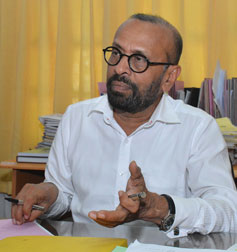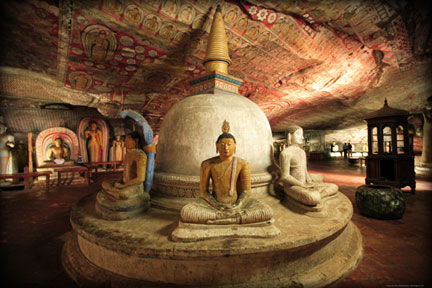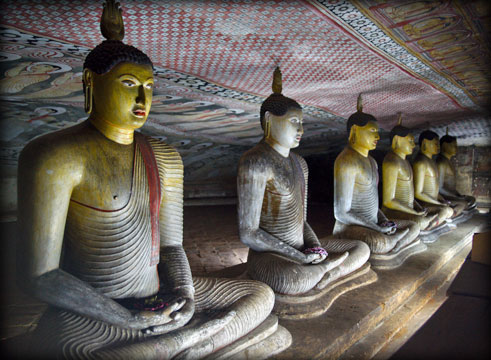Dambulla: Urgent action needed to preserve historic site
 Sri Lanka is comparatively small, but it has eight natural and
manmade sites on the UNESCO World Heritage Sites List. Only a few other
much bigger countries such as Argentina, Brazil, Australia and Spain
have more sites on the list. This is a matter of pride for Sri Lanka.
The World Heritage sites in Sri Lanka are Sigiriya, Anuradhapura,
Polonnaruwa, Dambulla (Golden Temple), Kandy, Galle, Central Highlands
and Sinharaja Forest Reserve. Sri Lanka is comparatively small, but it has eight natural and
manmade sites on the UNESCO World Heritage Sites List. Only a few other
much bigger countries such as Argentina, Brazil, Australia and Spain
have more sites on the list. This is a matter of pride for Sri Lanka.
The World Heritage sites in Sri Lanka are Sigiriya, Anuradhapura,
Polonnaruwa, Dambulla (Golden Temple), Kandy, Galle, Central Highlands
and Sinharaja Forest Reserve.
Out of these, Dambulla is in the news these days due to a controversy
over its state of repair. Dambulla is a mural painting site as well as
an archaeological site. A sacred pilgrimage site for 22 centuries, this
cave monastery, with its five sanctuaries, is the largest,
best-preserved cave-temple complex in Sri Lanka. The Buddhist mural
paintings (covering an area of 2,100 m2 ) are of particular importance,
as are the 157 statues.
Head of the Postgraduate Institute of Archaeology, Professor Jagath
Weerasinghe laments there is no comprehensive conservation program for
Dambulla. The Department of Archaeology has just four people to look
after this magnificent structure but that is not sufficient. The paint
layer in Dambulla is very sensitive to water, chemicals and humidity. It
is different from Sigiriya as the inorganic pigments are stuck onto the
paintings. These paintings have gone through what is called the natural
frescoes reaction.
Conservation
"The Dambulla restoration and conservation program is not in place.
There is tension in managing all the archaeological sites especially in
tourist destinations such as Dambulla, Sigiriya and Polonnaruwa," says
Prof. Jagath Weerasinghe adding the Tourist Board does not have the
expertise to manage the site. According to the Department of Archaeology
and the Central Cultural Fund, there is a lot of interest in preserving
heritage sites because it generates a lot of revenue. Archaeology and
History have become popular subjects. He further says that Dambulla is
in an uncertain position because the World Heritage Commission was
considering de-listing it from the World Heritage List.
|

Prof Jagath Weerasinghe Pix: Sarath Peiris |
 He further explains that heritage sites do not belong only to the
government and the archaeologists. It also belongs to the villagers and
the public. Their aspirations should be incorporated into the heritage
management plan. That is where the problem begins because of their old
fashioned attitudes. Visitors to heritage sites have increased because
the population has increased but the heritage management plan is not
addressing that issue. He further explains that heritage sites do not belong only to the
government and the archaeologists. It also belongs to the villagers and
the public. Their aspirations should be incorporated into the heritage
management plan. That is where the problem begins because of their old
fashioned attitudes. Visitors to heritage sites have increased because
the population has increased but the heritage management plan is not
addressing that issue.
The Antiquities ordinance is not wide enough to suit the perspectives
of 21st Century. There is a conflict between heritage management and
traditional custodians. These monuments are linked to many associated
communities. In Sri Lanka there is a failure in managing world heritage
sites because people have not understood the complexity of the
contemporary socio-political context, he noted.
"An inclusive approach which incorporates new ideas and a change of
policy for preserving archaeological sites is required. Everybody has an
opinion about archaeology. Everyone has an opinion about the past.
Archaeology recreates the idea of history and it is one way of knowing
and narrating the past. In Sri Lanka Archaeology has never been able to
become a seriously scientific discipline. UNESCO has asked Dambulla to
have a buffer zone and to develop a comprehensive management plan. None
of the World Heritage Sites in Sri Lanka has a comprehensive management
plan. Community development also takes place through archaeology and
heritage management because it brings revenue to a country.
Management
 Heritage cannot be preserved by experts alone especially in Sri Lanka
where sites are popular and are recreated in popular culture," he
observed. UNESCO has expressed concern about the lack of clear
management structures and clear lines of responsibilities at Dambulla
and in particular the lack of implementation of the Management Plan
which increases the problematic of conservation and pilgrim/visitor
management of the property, and therefore urges the State Party (the
Government of Sri Lanka) to: Establish a site management committee as a
matter of priority, including representatives of the government, Temple
authorities and the local community, as well as experts, Revise and
update the Management Plan based on clearly defined governance and
communication structures while incorporating traditional management
systems, that sets out the interface between the State and Temple
authorities, setting short-, mid- and long-term strategies for both
conservation and pilgrim/visitor management, as well as budget planning,
and to provide the draft to the World Heritage Centre, for review by the
Advisory Bodies and Develop a Conservation Strategy, as part of the
revised Management Plan, to address the conservation needs, develop a
pilgrim/visitor Management Strategy to control the number of
pilgrims/visitors allowed into each cave, as well as a policy
prohibiting flash photography within the caves. Heritage cannot be preserved by experts alone especially in Sri Lanka
where sites are popular and are recreated in popular culture," he
observed. UNESCO has expressed concern about the lack of clear
management structures and clear lines of responsibilities at Dambulla
and in particular the lack of implementation of the Management Plan
which increases the problematic of conservation and pilgrim/visitor
management of the property, and therefore urges the State Party (the
Government of Sri Lanka) to: Establish a site management committee as a
matter of priority, including representatives of the government, Temple
authorities and the local community, as well as experts, Revise and
update the Management Plan based on clearly defined governance and
communication structures while incorporating traditional management
systems, that sets out the interface between the State and Temple
authorities, setting short-, mid- and long-term strategies for both
conservation and pilgrim/visitor management, as well as budget planning,
and to provide the draft to the World Heritage Centre, for review by the
Advisory Bodies and Develop a Conservation Strategy, as part of the
revised Management Plan, to address the conservation needs, develop a
pilgrim/visitor Management Strategy to control the number of
pilgrims/visitors allowed into each cave, as well as a policy
prohibiting flash photography within the caves.
UNESCO has requested the State Party to submit to the World Heritage
Centre, by 1 December 2017, an updated report on the state of
conservation of the property and the implementation of the above, for
examination by the World Heritage Committee at its 42nd session in 2018.
|

